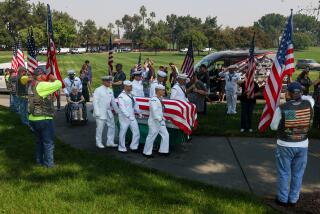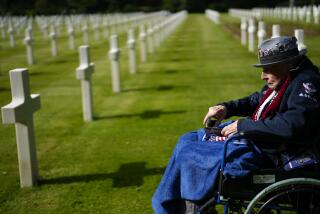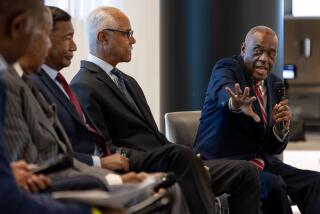WWII pilot makes a final journey home
- Share via
Two weeks after he left Orange County for World War II, Army Air Forces 2nd Lt. Ray Packard took off in his P-38 Lightning fighter on a bombing mission over German-occupied France. It took him 64 years to return home.
Packard’s plane was among 11 shot down Aug. 25, 1944, when their squadron was overwhelmed in a dogfight with 80 German fighters over Beauvais, a rural area north of Paris. Five of the pilots survived and eluded capture. Two were taken prisoner. The remains of three pilots listed as missing in action were eventually recovered.
The fate of 20-year-old Packard remained a mystery.
“I was 8 years old when my parents got a call in the middle of the night saying my Uncle Ray was missing,” said Ron Packard, 72, a nephew who grew up in Orange County and now lives in Lake Havasu City, Ariz. “It hit my family like a thunderstorm. It weighed on my dad significantly.”
In August, another phone call from the Army came out of the blue and rekindled those emotions. The remains of Ron Packard’s uncle had been found and would be returned to the United States.
The efforts made to find and repatriate missing troops from the Vietnam War are widely recognized. Of the more than 2,600 troops missing in action at the war’s end, the remains of 896 have been recovered, the Defense Department says.
Far less known is the work that has quietly gone on for decades to repatriate the missing from World War II. The number of open cases is staggering -- more than 74,000 across Europe, Africa, Asia and the Pacific.
“When I first came to work for this agency, that’s all I thought it was -- seeking remains from Vietnam,” said Larry Greer, a former Air Force colonel who is director of public affairs for the Pentagon’s POW/Missing Personnel Office. “That’s only a small part of the picture.”
The jungles of islands in the Pacific hide countless downed planes from World War II. Across Europe, farmers plowing fields or developers cutting new roads routinely stumble upon war remains or other evidence -- a scrap of metal stamped with a serial number, for instance -- that leads U.S. military archaeologists to excavate an area.
When the war ended, battlefields in Europe and the Pacific were searched for missing troops. About 79,000 positive identifications were made at forensic laboratories in Germany and Japan between 1945 and 1951, when the trail turned cold.
Renewed efforts began in the mid-1970s and centered on Papua New Guinea, where hundreds of known crash sites had been left untouched since the war. In recent years, stepped-up efforts in Russia, Eastern Europe and Japan have yielded new finds. In 2007, investigators searched Iwo Jima, where 150 troops are unaccounted for. It was the first search of the island since 1948, and although no remains were found, promising sites were identified for future excavation.
“It’s miraculous how they can take a zipper from a buried site . . . and tell what type of uniform it was on and when it was made,” Greer said. That information can then be cross-referenced with the military’s vast paper archives for clues pointing to a specific unit or plane crew that’s unaccounted for.
Since 1976, the remains of about 400 troops missing from WWII have been identified at the military’s POW/MIA forensics lab in Hawaii. The process can take decades.
The search for Ray Packard began in 1951. An Army team investigating potential grave sites in Europe interviewed a French man who said he found human remains from a P-38 crash near where Packard’s plane was last seen. The mayor of the small town of Angy told investigators the remains were buried in a local cemetery and later exhumed. What became of them wasn’t known.
The case was reopened 55 years later, in 2006, when military investigators went back to Angy to interview a local aircraft wreckage hunter who found human remains in a field. U.S. military officials conducted two excavations and found more remains, aircraft wreckage -- and Ray Packard’s dog tags.
“For families, finally knowing what happened is what’s most important,” Greer said. “There’s still a lot of emotion there even after all these years.”
In Packard’s case, the immediate family that’s left to remember him consists of one person: his nephew Ron, a retired Air Force veteran who served three tours of duty in Vietnam.
The Army presented Packard with a small box containing his uncle’s dog tags. In late October, Ray Packard was interred at Arizona’s Prescott National Cemetery in a service that attracted about 100 veterans of all ages who didn’t know the man.
“He was my favorite uncle,” said Ron Packard, who opted for Prescott instead of Arlington National Cemetery so he could easily visit. “He always had a smile on his face, and every time he came over to our home, he had some kind of toy for me and my brother.
“I take comfort in knowing that he’s finally home.”
--
More to Read
Sign up for Essential California
The most important California stories and recommendations in your inbox every morning.
You may occasionally receive promotional content from the Los Angeles Times.









